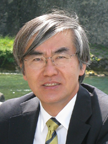The Fifth International Conference on Mobile Computing and Ubiquitous Networking (ICMU 2010)
Sponsored by Information Processing Society of Japan (IPSJ) SIG-MBL and SIG-BCC,
supported by IPSJ SIG-ITS and SIG-UBI
April 26 - 28, 2010 in Seattle, U.S.A.
Panel Session
Theme: Toward the EverGreen future
This panel theme is inspired from WA's nickname: THE EVERGREEN STATE. The main goal is to delineate future research directions on mobile and ubiquitous computing from the "green" viewpoints through the discussion with the audience. All the participants are also expected to share: the knowledge of current energy consumption problems in today's computer communication systems, and state-of-the-art technologies on energy saving, carbon dioxide reduction, etc.
Moderator:
Teruyuki Hasegawa (KDDI R&D Labs)
Panelists:
Tohru Asami (Univ of Tokyo)
Victor Bahl (Microsoft Research)
Mario Gerla (UCLA)
John D. Kapson (Oracle)
Atushi Murase (NTT DOCOMO)

Tohru Asami
Professor
Dept. of Information and Communication Engineering,
Graduate School of Information Science and Technology
University of Tokyo
Presentation Title: NEDO Project on Development of Next-Generation Highly-Efficiency Network Device Technology - Project Status Towards Energy Saving -
Abstract: This paper shows the interim report of the development project on Next Generation Highly Efficient Network Technology, sponsored by New Energy and Industrial Technology Development Organization (NEDO), in the fiscal years from 2007 to 20011. The project aim is to develop high speed and energy-saving devices as well as traffic control technologies to satisfy the demands of telecommunication service as the infrastructure for the future information society. Three classes of energy saving are investigated: (1) Optical transmitter/receiver, (2) Switch backplane, (3) OTDM-NIC for Optical Path Switching. The first one is to reduce the power of 100GE and 40GE optical transceiver and receiver, each of which runs with 10mW/Gbps(25Gbps). The second is to replace the electrical backplane with 25Gbps-based optical links. The third class is to develop 160Gbps OTDM-NIC for Optical Path Switching to replace a packet switching module.
Biography: Tohru Asami (asami@computer.org) received B.E. degree and M.E. degree in electrical engineering from Kyoto University, and Ph.D. from University of Tokyo. In 1976, he joined KDD (KDDI). Since that time, he has been working at KDD/KDDI R&D Laboratories in several research areas such as facsimile terminals, UNIX-based data communication systems, network management systems, and various access media to the Internet. In 1985, he developed an accounting system for the Internet gateway for Japanese academic networks, and until 1994 he was organizing the semi-commercial Internet gateway service for Japanese academic networks in cooperation with of UUNET, EUNET, etc. In 1997, he drove the first open xDSL Field Trial in Japan with several companies in Nagano Prefecture, to promote the possibility of ADSL in the Japanese telecommunication environments. After experiencing a board member of several Internet-related subsidiary companies of KDD/KDDI, he was a C.E.O. of KDDI R&D Labs. Inc. from 2001. From Apr. 1, 2006, he has been a professor of The University of Tokyo (Dept. of Information and Communication Engineering, Graduate School of Information Sciuence and Technology). He is a member of the IEEE. From 2003 to 2005, he was a vice chairman of the board of directors of Information System Society in The Institute of Electronics, Information and Communication Engineers, Japan (IEICE-ISS).

Victor Bahl
Principal Researcher and founding Manager
Microsoft Research, Redmond
Presentation Title: Greening the Enterprise & Datacenters
Abstract: Reducing the energy consumption of PCs and servers is becoming increasingly important with rising energy costs and environmental concerns. In enterprise networks, idle desktop machines rarely sleep, because users and IT departments want them to be always accessible. In mega datacenters the energy cost can have a crippling effect on the business model. I will discuss some on-going work in Microsoft Research that aims at reducing PC energy and server energy usage in the large and small enterprises. Specifically, I will discuss (a) Somniloquy, a hardware architecture that augments network interfaces allowing PCs that are in suspend to RAM sleep state to be responsive to network traffic; (b) a Sleep Proxy system, that has been deployed in Microsoft Research and has been operational for over 6 months (c) JouleMeter, a tool that shows the breakdown of the application energy usage by individual components (disk, CPU, memory) for regular PCs, and (d) Widsom, centralized request routing scheme that optimizes the performance and energy cost of large scale cloud services. I will share some lessons learnt.
Biography: Victor Bahl is a Principal Researcher and founding Manager of the Networking Research Group in Microsoft Research Redmond. He is responsible for directing research activities that push the state-of-art in the networking of devices and systems. He and his group build proof-of-concept systems, engage with academia, publish papers in prestigious conferences and journals, publish software for the research community, and work with product groups to influence Microsoft's products. His personal research interests span a variety of topics in wireless systems design, mobile networking, and network management. He has built and deployed several seminal and highly cited networked systems, with a total of over 9000 citations; he has authored over 85 papers and 116 patent applications, 68 of which have issued; he has won best paper awards at SIGCOMM and CoNext and has delivered over two dozen keynote & plenary talks; he is the founder and past Chairperson of ACM SIGMOBILE; the founder and past Editor-in-Chief of ACM Mobile Computing and Communications Review, and the founder and steering committee chair of the MobiSys; He has served as the General Chair of several IEEE and ACM conferences including SIGCOMM and MobiCom, and is serving on the steering committees of seven IEEE & ACM conferences & workshop ; he has served on the board of over half-a-dozen journals; on several NSF, NRC and FCC panels, and on over seven dozen program committees. Dr. Bahl received Digital's Doctoral Engineering Fellowship Award in 1995 and SIGMOBILE's Distinguished Service Award in 2001. In 2004, Microsoft nominated him for the innovator of the year award. He is an ACM Fellow and an IEEE Fellow. When not working, he loves to read, travel, eat in fine restaurants, and spend time drinking with friends and family. More on him at http://research.microsoft.com/~bahl/highlights.aspx

Mario Gerla Professor
Computer Science Department
UCLA
Presentation Title: Green-City Transport Architecture: Closing the loop between sensors, navigators, and routes
Abstract: The major drivers of intelligent transport systems in recent years have been increased safety, improved traffic flow, and reduced fuel consumption and emissions ? with considerable success in each area. On a per passenger mile basis, traffic injuries and deaths are down significantly over the past 20 years, as are fuel consumption and emissions. These improvements, however, have been eroded significantly by the growth in population and the absolute scale of travel. Despite the higher vehicular safety and efficiency, the performance of vehicle systems is by many measures declining, especially in cities. Traffic congestion in U.S. metropolitan areas large and small is up dramatically over the past two decades, with negative effects on economic productivity, fuel consumption and air pollution. Our increasingly efficient vehicles are growing more "intelligent" than the road systems on which they operate. In this study we focus our attention on intelligent metropolitan traffic management with the aim of reducing congestion, pollution and traveler delays, and in the process also improving fuel consumption and emissions. Up to now, metropolitan traffic control has been implemented by rather elementary means: traffic signal controls based on local information (video cameras, sensor loops), congestion fees based on historical traffic data, and so on. But recent advances in communications, navigation, and sensor technologies present new opportunities to increase the intelligence and efficiency of metropolitan streets and highway networks. The pivotal element of intelligent transport architecture is the ability to "close the loop" between on-board sensors of road and vehicle conditions on one hand, and traffic management tools (signals, real-time information signs, variable tolls, etc.), traffic enforcement, and car navigators on the other. Keys to closing the loop are on-board navigators, navigation servers, and intelligent traffic signals. The signals control vehicle flows at intersections and interact with vehicle components (such as ignition systems) and vehicle sensors (collecting data on position, speed, emissions, etc.), which broadcast data to on-board navigators. The navigator server interacts with central traffic controllers and proposes optimal routes to the on-board navigators. In this project we will design an urban traffic management system that receives inputs from vehicles (e.g., sensor readings, position, preferences, etc), processes these inputs to generate a routing plan, and then implements the plans through navigators and traffic signals. Using the system proposed here, metropolitan traffic management will evolve to become a more sophisticated control system where "cyber intelligence and complexity" interacts with "physical" elements on board the vehicles. At the top state, regional and local traffic managers work with navigator servers to implement policies and optimize routing. In the middle, the traffic signals monitor the on-board environment sensors and broadcast local route advisories. At the bottom, the on-board navigator implements the routing instructions from navigator server and traffic signals. All this is made possible by effective vehicle to infrastructure communications, from 3G channels to (on-board/roadside) DSRC communications that enable real time, low cost, scalable information exchanges among the various architecture omponents. The overarching goal of this project is to develop a vehicular traffic monitoring and control system ? termed Green-City Transport Architecture ? that uses (a) the sensors and actuators available on the vehicle, (b) the vehicle communications infrastructure, and (c) a set of powerful traffic, congestion, and air quality modeling tools to carry out both short-term vehicular traffic routing/assignment and longer-term traffic planning. This project will be highly interdisciplinary; it will benefit from the collaboration and expertise of atmospheric science researchers, auto manufacturers, traffic signalization and control engineers, and vehicle navigation developers. The efficacy of our solution will be demonstrated via simulation, emulation, and small scale experimentation on a Campus Vehicular Test bed (CVET).
Biography: Dr. Mario Gerla is a Professor in the Computer Science at UCLA. He holds an Engineering degree from Politecnico di Milano, Italy and the Ph.D. degree from UCLA. He became IEEE Fellow in 2002. At UCLA, he was part of the team that developed the early ARPANET protocols under the guidance of Prof. Leonard Kleinrock. He joined the UCLA Faculty in 1976. At UCLA he has designed and implemented network protocols including ad hoc wireless clustering, multicast (ODMRP and CODECast) and Internet transport (TCP Westwood). He has lead the $12M, 6 year ONR MINUTEMAN project, designing the next generation scalable airborne Internet for tactical and homeland defense scenarios. He is now leading two advanced wireless network projects under ARMY and IBM funding. His team is developing a Vehicular Testbed for safe navigation, urban sensing and intelligent transport. A parallel research activity explores personal communications for cooperative, networked medical monitoring (see www.cs.ucla.edu/NRL for recent publications).

John D. Kapson
Managing Consultant, Data Center Efficiency Practice
Oracle
Presentation Title: Sustainable Computing
Abstract: "Sustainability" has been interpreted in many ways. In strict terms, sustainability implies consuming [natural] resources at a slower pace that with which they can be replenished. In more complex interpretations, it can encompass overlapping domains of economics, environment, and society. A simple definition used by both the United Nations Environment Programme and the International Union for Conservation of Nature is, "improving the quality of human life while living within the carrying capacity of supporting eco-systems."
Many factors effect the level of sustainability that a given IT organization can realize within their data centers. Reducing electrical consumption is paramount, but only a single aspect of eco-efficiency. In this panel presentation, we look at strategies beyond cooling efficiencies and power conservation that can be leveraged by organizations wishing to take a more holistic approach to sustainability. These strategies range from purely technical through to the business' operation and culture.
Biography: John Kapson is a Managing Consultant with Oracle's (formerly Sun Microsystems) global Data Center Efficiency Practice. With twenty-two years experience in high-tech, John has been with Sun for over half that, having held a variety of roles including Senior Java Architect, Java Center Practice Manager, and Product Portfolio Manager for SunGrid, Sun's earliest instantiation of "Cloud Computing." He has been a key contributor to numerous 'start up' business endeavors and has a talent and passion for strategy development, which he has applied to DCE consulting engagements including developing "Green IT" strategies for several global enterprises and public sector agencies. Another of his focus areas within the Data Center Efficiency Practice is business/economic modeling and simulation, leveraging his background and experience in various analytical modeling disciplines to assist customers with their strategic planning vis-à-vis data center efficiency projects.

Atsushi Murase
Managing Director of Research Laboratories
NTT DOCOMO
Presentation Title: Green ICT issues on Mobile Network Systems
Abstract: Mobile communication network in Japan has become a very huge and relevant infrastructure for the society. For example, NTT DOCOMO’s network system accommodates 55 million subscribers and consumes approximately 5% of total IT energy power in Japan. In this presentation, the power consumption in the mobile network is analyzed and possible future improvements on the network are discussed. Furthermore, understanding geographical population statistics estimated by cellular terminals movement, we see the mobile network could support more efficient and green society with fine balance between convenience and environment.
Biography: He received the Electronics and Communications Engineering bachelor degree from Waseda University, Tokyo in March 1981 and joined NTT directly. He received the Ph.D. degree in cellular radio control channel design for random access control and paging signal broadcasting from Waseda University in March 1991. He has broad experience from 1G to 3G mobile communication systems development especially for base stations, controllers and 3G FOMA terminals through more than 20 years activities in mobile communication R&D of NTT and NTT DOCOMO. He stayed at British Telecom Labs in UK from 1989 to 1990 as an exchanging researcher. He was President & CEO of DOCOMO Communications Laboratories Europe GmbH in Munich Germany from 2002 to 2005. He has been Managing Director of Research Laboratories, NTT DOCOMO since April 2007.
![[ICMU2010]](img/icmu2010logo.png)

